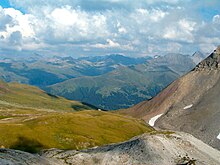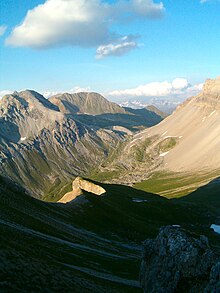Maienfelder Furgga
| Maienfelder Furgga | |||
|---|---|---|---|
|
Maienfelder Furgga between Schiesshorn (right) and Furggahorn, to the left of which Tiejer and Mederger Flue. Bärenbadschanze at the bottom right . |
|||
| Compass direction | west | east | |
| Pass height | 2436 m above sea level M. | ||
| Canton | Graubünden , Switzerland | ||
| Watershed | Plessure | Land water | |
| Valley locations | Arosa | Davos Frauenkirch , Davos Glaris | |
| expansion | Mountain hiking trail | ||
| Mountains | Plessur Alps | ||
| map | |||
|
|
|||
| Coordinates | 775 261 / 182 505 | ||
The Maienfelder Furgga (also: Furgga , Aroser Furgga ; earlier spelling: Furka ) is an alpine pass in the Swiss canton of Graubünden . With a peak height of 2436 m above sea level. M. connects Arosa in Schanfigg with Frauenkirch and Glaris in Landwassertal .
description
A frequently used, marked hiking trail leads across Maienfelder Furgga, located in the middle of the Strela chain between the Furggahorn and the Amselflue , in summer . This also serves as an ascent or descent route to the above-mentioned peaks as well as to Tiejer Fürggli and Schwifurgga (Furggaltji).
History and origin of name
Since the settlement of the Arosa neighborhood by Walser families in the early 14th century, Maienfelder Furgga has been the most important and fastest connection to the mother community of Davos for a long time . The crossing was used in both summer and winter, whereby the troubles and dangers that the travelers had to take on in the cold season were enormous. Last but not least, this geographically determined circumstance finally led to the establishment of an independent municipality of Arosa in 1851.
The rather confusing, but since the introduction of the new national map of Switzerland from 1938 onwards, the name of the passport originates from the fact that in 1561 the town of Maienfeld acquired the Furggaalp located on the Schanfigger Höhenweg between the Isel and Grünsee reservoirs from the Churwalden monastery , which also includes areas on the pass path (Furggabodäli and Obersäss) belonged. As a result, over the centuries it became common practice to add Maienfelder to the pass to distinguish it from the other Furgga that also lead to Arosa (Valbella Furgga, Alteiner Fürggli, Bärentaler Furgga, Tiejer Fürggli and Schwifurgga) . In the Davos landscape , the name Chummerfurgga - from the Chummerberg alpine area belonging to the Chummen settlement - was also used in the past .
Winter crossing by Arthur Conan Doyle
The first known crossing of the Maienfelder Furgga on skis was made in March 1893 by the brothers Johann and Tobias Branger from Davos. The doctor and writer Arthur Conan Doyle , who was there at the time, found out about it and hired the two of them as ski instructors the following winter to repeat the tour with them. After seven hours of climbing and descending, they reached Arosa. As a result, Doyle described the undertaking in detail in the English magazine Strand Magazine , which contributed significantly to the fact that skiing and winter holidays in Switzerland became popular with the English upper class.
At the beginning of April 1986 the Austrian radio ORF recreated this ski tour for a television film with an actor as Doyle and the Arosa mountain guides Peter Meisser and Rudolf Homberger as Branger brothers. The three of them covered the original route in historical equipment and then lodged, like their role models, in Arosa's oldest hotel, the Seehof near Untersee , where further extensive film recordings were made.
Furggabahn project

During the construction of the Arosa Railway in 1913, the planner of the same, the Chur engineer Robert Wildberger , together with H. Peter from Zurich, acquired, among other things, the concession to build a cog railway from Arosa station via Maienfelder Furgga to Davos. The construction costs were estimated at 3,250,000 Swiss Francs. However, the outbreak of the First World War prevented the realization of this project.
In 2008, as part of a cantonal project study, the feasibility of a rail tunnel connecting the valleys between Arosa and Davos or Langwies and Davos stations was examined. The first variant would run right under the Maienfelder Furgga. In view of the tight finances, the Graubünden government did not classify such a project as a priority.
Tourist use
From 1910 there were plans to build a refuge on the top of the pass. The so-called Furggahütte could not be realized until 1930 through a cooperation between the Arosa ski club and the Arosa and Davos spa associations. In 1986 the dilapidated emergency shelter was rebuilt and inaugurated with a small celebration. The official climbs to Furgga have a level of difficulty T2 . Further accesses lead from Alteinsee via Schiesshornfurgga and from Tieja / Schwifurgga via Tiejer Fürggli (each T3 ) to the pass.
Varia

Winter sports enthusiasts like David Zogg or - in the early years - the players from EHC Arosa crossed the Maienfelder Furgga with skis and hockey equipment to meet in Davos .
swell
- Hans Danuser : Arosa place and field names including the Welschtobel and some areas near the border in neighboring communities, self-published Danuser, Arosa 2011, ISBN 3-905342-49-9 , p. 144.
- Manfred Hunziker: Ringelspitz / Arosa / Rätikon, Alpine Touren / Bündner Alpen , Verlag des SAC 2010, ISBN 978-3-85902-313-0 , p. 369.
- Hans Danuser: Arosa - as it was then (1979-1995) , vol. 6, self-published by Danuser, Arosa 2002, p. 121.
- Ueli Haldimann (Ed.): Hermann Hesse, Thomas Mann and others in Arosa - texts and images from two centuries. AS Verlag und Buchkonzept, Zurich 2001, ISBN 3-905111-67-5 , pp. 44–51.
- Hans Danuser: Arosa - as it was then (1928-1946) , Vol. 3, self-published by Danuser, Arosa 1999, p. 48.
- Hans Danuser: Arosa - as it was then (1907–1928) , vol. 2, self-published by Danuser, Arosa 1998, p. 98 f.
- Hans Danuser: Arosa - as it was then (1850–1907) , vol. 1, self-published by Danuser, Arosa 1997, p. 89 ff.
- Hans Danuser, Walser Association Graubünden (ed.): Old ways in Schanfigg. Verlag Walser-Vereinigung Graubünden, Splügen 1997, p. 29 ff.
- Heinrich Tgetgel, Schweizer Wanderbuch 30 , Schanfigg – Arosa, 3rd edition, Bern 1971, p. 98 f.
- JB Casty: Arosa - From the local history of the world-famous health resort , Verlag Kur- und Verkehrsverein Arosa, Arosa 1959/60, p. 102.
- Fritz Maron: From mountain farming village to world health resort Arosa , Verlag F. Schuler, Chur 1934, p. 136, 166.
- The history of skiing in Arosa , commemorative publication for the thirtieth anniversary of the Arosa Ski Club, Arosa Ski Club (ed.), Arosa 1933, p. 43.


